Cyber bullying involves the use of information and technology such as e-mail, instant messaging, the publishing of defamatory personal websites, and online personal polling websites that are used to support conscious, willful, deliberate, repeated, and hostile behavior by one or more people with the intent to harm others.
Online harassment or threatening is Cyber bullying and it is on the rise.

“Am I hot or not?” It’s an Instagram game that is exploding on the Internet. Young girls around the age of 13 are posting photo of themselves on Instagram with #beautycontest, #rankme, #rateme and #amipretty hashtags and are looking for a quick virtual judgment of their beauty and in return they receive cruel or lewd comments that can damage their self-worth. Some of the photos are head shots and some are more risky, which are “sexting.” Obviously, these girls are not considering the privacy issue especially when hashtags are used or the variety of devastating comments this type of behavior solicits. Educators and parents made want to talk to their Instagramming kids and make them aware that the Internet is not a reliable place to seek self-worth or to post pictures to be rated by others.
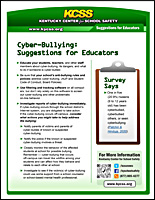 Educate your students, teachers, and other staff members about cyber-bullying, its dangers, and what to do if someone is cyber-bullied. (KCSS Handout)
Educate your students, teachers, and other staff members about cyber-bullying, its dangers, and what to do if someone is cyber-bullied. (KCSS Handout)
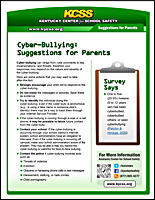 Cyber-bullying can range from rude comments to lies, impersonations, and threats, therefore your responses may depend on the nature and severity of the cyber-bullying. Here are some actions that you may want to take after the fact. (KCSS Handout)
Cyber-bullying can range from rude comments to lies, impersonations, and threats, therefore your responses may depend on the nature and severity of the cyber-bullying. Here are some actions that you may want to take after the fact. (KCSS Handout)
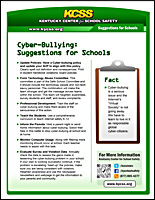 Suggestions include: Updating Policies, Forming a Technology Abuse Committee, Professional Development, Teaching the Students, Informing the Parents, Monitoring Computer Usage and Evaluating Survey and Violation Data. (KCSS Handout)
Suggestions include: Updating Policies, Forming a Technology Abuse Committee, Professional Development, Teaching the Students, Informing the Parents, Monitoring Computer Usage and Evaluating Survey and Violation Data. (KCSS Handout)
 What to do if you are Cyber-bullied, How to Prevent being Cyber-bullied, and How to Prevent being a Cyber-bully. (KCSS Handout)
What to do if you are Cyber-bullied, How to Prevent being Cyber-bullied, and How to Prevent being a Cyber-bully. (KCSS Handout)
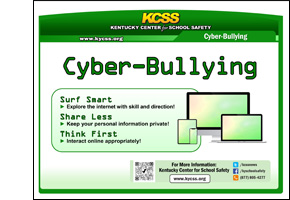 Promotional Poster Encouraging Students to Surf Smart, Share Less, and Think First. (KCSS Handout)
Promotional Poster Encouraging Students to Surf Smart, Share Less, and Think First. (KCSS Handout)
 (KCSS) (From the Ad Council-YouTube videos)
(KCSS) (From the Ad Council-YouTube videos)
The Kitchen (video) Writing Prompt (handout)
Talent Show (video) Writing Prompt (handout)
Bulletin Board (video) Writing Prompt (handout)
Everyone Knows Your Name (video) Writing Prompt (handout)
General Writing Prompt (handout)
 Get all the tools you need with a FREE Digital Literacy and Citizenship Curriculum and Parent Media Education Program. The relevant, ready-to-use instruction helps educators guide students to make safe, smart, and ethical decisions in the digital world where they live, study and play. Also, Common Sence Media has a feature called Digital Passport, which teaches and tests basics of online life for 5-8 grade. This site also has a list of “Websites to Stop Bullying Online“.
Get all the tools you need with a FREE Digital Literacy and Citizenship Curriculum and Parent Media Education Program. The relevant, ready-to-use instruction helps educators guide students to make safe, smart, and ethical decisions in the digital world where they live, study and play. Also, Common Sence Media has a feature called Digital Passport, which teaches and tests basics of online life for 5-8 grade. This site also has a list of “Websites to Stop Bullying Online“.
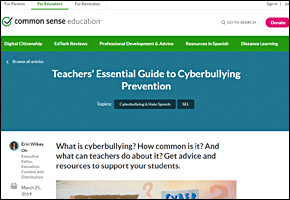 What is cyberbullying? How common is it? And what can teachers do about it? Get advice and resources to support your students. Also, when others see cyberbullying, what can they do? In these situations, people can be bystanders, allies, or upstanders.
What is cyberbullying? How common is it? And what can teachers do about it? Get advice and resources to support your students. Also, when others see cyberbullying, what can they do? In these situations, people can be bystanders, allies, or upstanders.
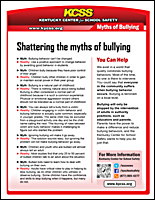 Topics on this handout include: “Shattering the myths of bullying”, “You Can Help”, “Who’s the bully… not my child!” and “Why don’t kids ask for help?” (KCSS 2-Sided Handout)
Topics on this handout include: “Shattering the myths of bullying”, “You Can Help”, “Who’s the bully… not my child!” and “Why don’t kids ask for help?” (KCSS 2-Sided Handout)
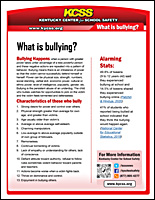 Topics on this handout include: “Characteristics of those who bully”, “Alarming Stats” and “Who are the victims?” (KCSS 2-Sided Handout)
Topics on this handout include: “Characteristics of those who bully”, “Alarming Stats” and “Who are the victims?” (KCSS 2-Sided Handout)
(When one student targets another online)
How can you prevent being cyber bullied?
How can you prevent miscommunication or becoming a cyber bully?
Questions before you post or send
It is always hurtful, sometimes unlawful and sometimes changes lives forever…
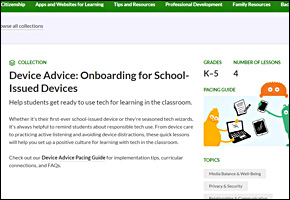 Common Sense Media – Help students get ready to use tech for learning in the classroom. Whether it’s their first-ever school-issued device or they’re seasoned tech wizards, it’s always helpful to remind students about responsible tech use. From device care to practicing active listening and avoiding device distractions, these quick lessons will help you set up a positive culture for learning with tech in the classroom. Check out the Device Advice Pacing Guide for implementation tips, curricular connections, and FAQs.
Common Sense Media – Help students get ready to use tech for learning in the classroom. Whether it’s their first-ever school-issued device or they’re seasoned tech wizards, it’s always helpful to remind students about responsible tech use. From device care to practicing active listening and avoiding device distractions, these quick lessons will help you set up a positive culture for learning with tech in the classroom. Check out the Device Advice Pacing Guide for implementation tips, curricular connections, and FAQs.
 Common Sense Media – Research-based lessons to support students’ social-emotional learning and digital well-being. Media and tech have a way of magnifying the stress that young people face on a daily basis. But why is that the case? And more importantly, what can they do about it (besides just taking a break from their phones)? Support students’ digital well-being with this set of evidence-based lessons. Each is designed to help them build agency, reduce anxious thoughts, and increase mindfulness related to their tech habits. This collection was co-developed by Common Sense Education and the Center for Digital Thriving at Harvard Graduate School of Education. Check out the Digital Well-Being Pacing Guide for implementation tips, curricular connections, and FAQs.
Common Sense Media – Research-based lessons to support students’ social-emotional learning and digital well-being. Media and tech have a way of magnifying the stress that young people face on a daily basis. But why is that the case? And more importantly, what can they do about it (besides just taking a break from their phones)? Support students’ digital well-being with this set of evidence-based lessons. Each is designed to help them build agency, reduce anxious thoughts, and increase mindfulness related to their tech habits. This collection was co-developed by Common Sense Education and the Center for Digital Thriving at Harvard Graduate School of Education. Check out the Digital Well-Being Pacing Guide for implementation tips, curricular connections, and FAQs.
 NetSmartz – Empower your students to be safer online with our free collection of teaching materials for students in grades K-12. With videos, lesson plans, games and more, NetSmartz can help you create a dynamic and engaging Internet safety curriculum.
NetSmartz – Empower your students to be safer online with our free collection of teaching materials for students in grades K-12. With videos, lesson plans, games and more, NetSmartz can help you create a dynamic and engaging Internet safety curriculum.
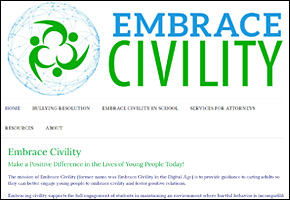 The mission of Embrace Civility (former name was Embrace Civility in the Digital Age) is to provide guidance to caring adults so they can better engage young people to embrace civility and foster positive relations.
The mission of Embrace Civility (former name was Embrace Civility in the Digital Age) is to provide guidance to caring adults so they can better engage young people to embrace civility and foster positive relations.
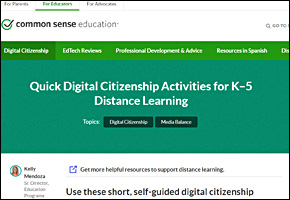 Common Sense – Digital citizenship is more important than ever as students experience school virtually, in one form or another. Common Sense has a collection of short digital citizenship activities that students can complete independently, or with parents or caregivers.
Common Sense – Digital citizenship is more important than ever as students experience school virtually, in one form or another. Common Sense has a collection of short digital citizenship activities that students can complete independently, or with parents or caregivers.
 NCMEC’s CyberTipline is the nation’s centralized reporting system for the online exploitation of children.
NCMEC’s CyberTipline is the nation’s centralized reporting system for the online exploitation of children.
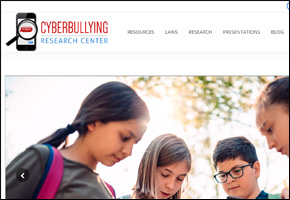 The Cyberbullying Research Center is dedicated to providing up-to-date information about the nature, extent, causes, and consequences of cyberbullying among adolescents.
The Cyberbullying Research Center is dedicated to providing up-to-date information about the nature, extent, causes, and consequences of cyberbullying among adolescents.
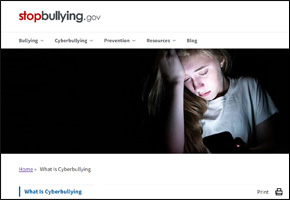 Cyberbullying is bullying that takes place over digital devices like cell phones, computers, and tablets. Cyberbullying can occur through SMS, Text, and apps, or online in social media, forums, or gaming where people can view, participate in, or share content.
Cyberbullying is bullying that takes place over digital devices like cell phones, computers, and tablets. Cyberbullying can occur through SMS, Text, and apps, or online in social media, forums, or gaming where people can view, participate in, or share content.
 Emailing and chatting with friends are children’s most common online activities, after studying and playing games. But like many other social situations, some kids bully other kids online. The National Crime Prevention Council provides information and resources to help curb the growing problem of cyberbullying. (downloadable resources include brochures, podcasts, PSAs, etc.)
Emailing and chatting with friends are children’s most common online activities, after studying and playing games. But like many other social situations, some kids bully other kids online. The National Crime Prevention Council provides information and resources to help curb the growing problem of cyberbullying. (downloadable resources include brochures, podcasts, PSAs, etc.)
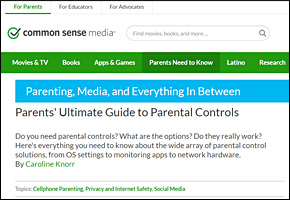 Advice from Common Sense Media editors. … Parental controls can support you in your efforts to keep your kids’ Internet experiences safe, fun, and productive.
Advice from Common Sense Media editors. … Parental controls can support you in your efforts to keep your kids’ Internet experiences safe, fun, and productive.
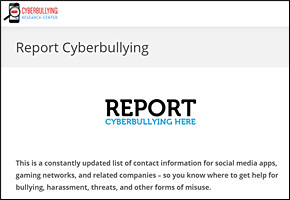 Cyberbullying Research Center provides links and contact information to report abusive content on: Social Media, Messaging Services, Classifieds, Search Engines, Cell Phone Service Providers, Internet Service Providers and Gaming
Cyberbullying Research Center provides links and contact information to report abusive content on: Social Media, Messaging Services, Classifieds, Search Engines, Cell Phone Service Providers, Internet Service Providers and Gaming
 Readiness and Emergency Management for Schools (REMS) Technical Assistance (TA) Center researched how cyber incidents affect education agencies and the steps they can take to respond – describing what schools can do before, during, and after an incident. This also includes the most common cyber threats to students, including cyberbullying.
Readiness and Emergency Management for Schools (REMS) Technical Assistance (TA) Center researched how cyber incidents affect education agencies and the steps they can take to respond – describing what schools can do before, during, and after an incident. This also includes the most common cyber threats to students, including cyberbullying.
 Cyberbullying Research Center – A brief review of state cyberbullying laws and policies.
Cyberbullying Research Center – A brief review of state cyberbullying laws and policies.
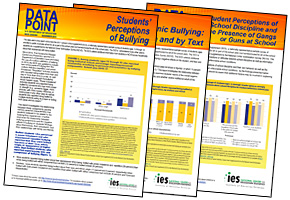 National Center for Education Statistics (November 2019) released three Data Point Reports entitled Students’ Perceptions of Bullying; Electronic Bullying: Online and by Text; and Student Perceptions of School Discipline and the Presence of Gangs or Guns at School. These reports examine the characteristics and school behaviors of students who report bullying online or by text; the extent to which students experiencing different components of bullying report their perceived relationship of bullying to the student’s personal characteristics; and how student perceptions of school discipline vary by student reports of their own behaviors in school and unfavorable school conditions experienced.
National Center for Education Statistics (November 2019) released three Data Point Reports entitled Students’ Perceptions of Bullying; Electronic Bullying: Online and by Text; and Student Perceptions of School Discipline and the Presence of Gangs or Guns at School. These reports examine the characteristics and school behaviors of students who report bullying online or by text; the extent to which students experiencing different components of bullying report their perceived relationship of bullying to the student’s personal characteristics; and how student perceptions of school discipline vary by student reports of their own behaviors in school and unfavorable school conditions experienced.